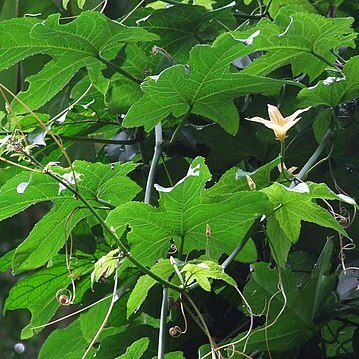Leaf-lamina 7–18 × 7–20 cm., broadly ovate in outline, cordate, deep green, glabrous or shortly pubescent on veins beneath and less so above, punctate, shallowly to deeply palmately 5-lobed, the lobes triangular or broadly ovate to elliptic, subentire to coarsely sinuate-dentate, rounded or obtuse, apiculate, the central largest.
Female flowers solitary or paired; peduncle 8–22 mm. long; ovary 20–36 × 1·5–2·5 mm., cylindrical, glabrous; receptacle-tube c. 3–5 mm. long, campanulate, lobes 3–7 mm. long, lanceolate, acute; corolla often larger than in male flowers, otherwise similar.
Fruit 8–30 × 1·5–2·5 cm., cylindrical, terete, bright red; fruit-stalk stout, 4–6·5 cm. long, expanded upwards.
Stems scandent or prostrate, vigorous, shortly pubescent or almost glabrous.
Seeds 4·5–4·7 × 2·5–2·7 × 1·3 mm., ovate, compressed, obscurely bordered.
Tendrils 2-fid, one branch often very weakly developed, rarely simple.
Petioles 3·5–9 cm. long, usually pubescent.
Probracts 3–8·5 mm. long, spathulate.


